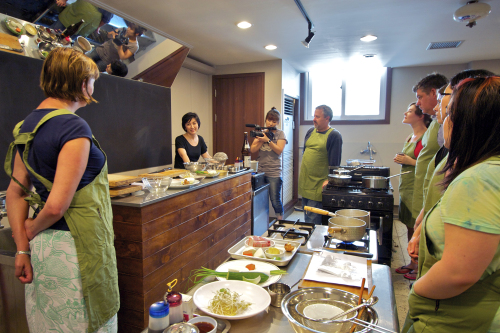What comes to mind first when you think of Korea? Is it movies that thrill fans around the world? Or the achingly tragic history of a divided country? According to a survey conducted by the Voluntary Agency Network of Korea, a non-governmental organization of “cyber diplomats,” the answer is most likely to be “food.”
VANK conducted a survey last year of around 1,500 foreigners in Korea about what the foreigners’ main interests are in Korea. Among 14 categories, including movies, dramas, food, music, sports, language, history, economy and celebrities, 41 percent of respondents (900 people) said they were most interested in Korean food, far greater than the second-highest percentage of 23 percent in dramas. Interestingly, another survey conducted by the Korea Trade-Investment Promotion Agency on the same subject drew the exact same results.
VANK conducted a survey last year of around 1,500 foreigners in Korea about what the foreigners’ main interests are in Korea. Among 14 categories, including movies, dramas, food, music, sports, language, history, economy and celebrities, 41 percent of respondents (900 people) said they were most interested in Korean food, far greater than the second-highest percentage of 23 percent in dramas. Interestingly, another survey conducted by the Korea Trade-Investment Promotion Agency on the same subject drew the exact same results.

Today people are becoming more health-conscious, and this trend has ignited a turf war in the food industry worldwide. Amid fierce battles over the merits of various national cuisines around the world, Korean food is becoming well-recognized for its nutritional and health benefits. With a backlash against nouvelle cuisine, “slow food” is prevailing and Korean food is gaining momentum as a world cuisine. Vegetables rather than meat are the primary ingredients used in Korean food, and fermented food such as kimchi or soybean paste are a healthy choice. The World Health Organization and the Financial Times have described Korean food as exemplary, well-balanced, and suitable for a modern society where processed foods are considered the main cause of health risks such as heart disease and obesity.
The Korea Tourism Organization has launched a new website (www.koreataste.org) which offers information about Korean food along with local restaurant reviews by food experts and food columns so that visitors can learn more about Korean cuisine and culture. At the same time, more blogs are appearing run by foreign residents who love Korean food. They are posting recipes to share the delights and benefits of Korean food with other foreigners. But reading a recipe is one thing and actually making it is another, especially to those who are new to cooking or Korean food. For those who find it difficult to cook Korean food, Korean cuisine cooking classes are wide open to expats.
Seouleats.com
Seoul Eats is a blog-based website that features food recipes, restaurant reviews and many interesting food-related stories. It organizes various Korean culinary tours such as the Korean night tour and the Korean taste tour so that visitors can explore Korean culture while enjoying food and learning about Korean history and culture from experts. Seoul Eats is running a culinary school, O’ngo Food Communications, and it offers cooking classes in beginning, and intermediate to professional programs for each individual’s needs or abilities. Classes are taught in English and Japanese and the beginners’ program covers bulgogi, kimchi, dakgalbi (spicy chicken barbeque), haemul pajeon (seafood pancake), sundubu (soft totu stew) and dolsot bibimbap (stone bowl spicy mixed rice).
Location: From Jongno 3-ga station (Subway Line 5) Exit 5, make a right at SCH bank and then make the next right. It is across from the Crown Hotel.
Address: Jongno-gu, Nagwon-dong 55-1, 3rd floor, Seoul
www.seouleats.com
www.ongofood.com
Tel. (02)3446-1607
Institute of Korean Royal Cuisine
The Institute of Korean Royal Cuisine is where the traditions of Korean Royal Cuisine are maintained. Royal cuisine, referred as the genuine Korean traditional cuisine, is designated as an Intangible Cultural Asset by the government. The Institute of Korean Royal Cuisine is located at the end of the west wall of Changdeokgung Palace in an environment rich with history and tradition. It offers a cooking lesson for people from overseas. You will learn how to make Gojolpan (a wrap dish), Bosam (boiled pork served with vegetables), Kimchi, dumpling soup, and others.
When: every 2nd, 3rd, 4th Saturday (September November 2010)
Address: 34, Wonseo-dong, Jongno-gu, Seoul
http://www.food.co.kr/english/01.html
Tel: (02) 3673-1122~3
Yoo’s Family
Yoo’s Family is a traditional, in-house cultural program, offered by the Yoo family. Yoo’s Family provides an opportunity to experience traditional games like yut-nori (a game a bit like ludo), painting “sagunja” (the four gracious plants), woodblock printing, and calligraphy while staying in a traditional Korean house, or hanok. At Yoo’s Family, you will learn how to make various dishes including kimchi, jeon (Korean pancakes), bulgogi and tteokbokki.
http://www.yoosfamily.com
E-mail: visithome@korea.com
Tel: (02)3673-0323
Lasunjae: the Restaurant of Shilla Millennium Cuisine
Gyeongju, designated as a UNESCO World Heritage Site, is “a museum without walls.” At many historical sites, you can encounter not only the culture and history of Gyeongju but can also have a special experience at a Lasunjae restaurant, where you will be served dishes prepared from ancient Silla court recipes. Lasunjae, where the 1,000 year history of the Silla Dynasty is still alive, is located in the Bomun Complex in Gyeongju. The restaurant houses a culinary school, a museum, and the restaurant itself. The restaurant offers tourists a hands-on experience making medicinal foods.
Address: 375-3 Sinpyeong-ri, Gyeongju-si, Gyeongsangbuk-do
www.culinaryschool.co.kr/lasonjae
Tel: (054) 771-6040
By By Michelle Kang
Michelle Kang is English Editor at Seoul Global Center. She can be reached at michyk@sba.seoul.kr Ed.


















![[Today’s K-pop] BTS pop-up event to come to Seoul](http://res.heraldm.com/phpwas/restmb_idxmake.php?idx=642&simg=/content/image/2024/04/17/20240417050734_0.jpg&u=)